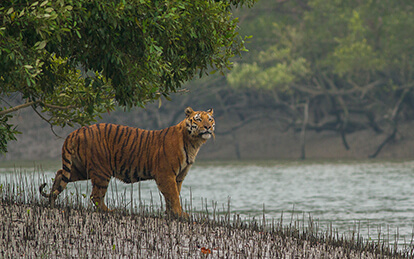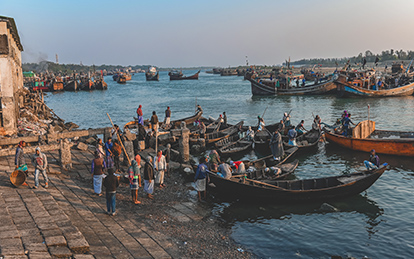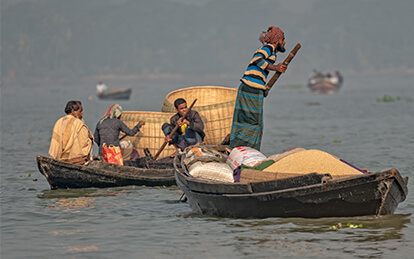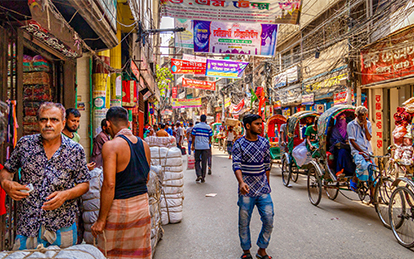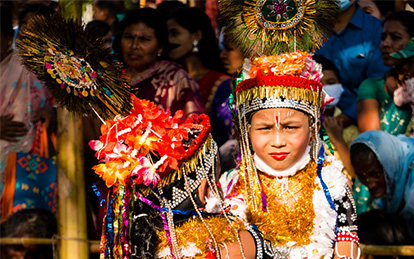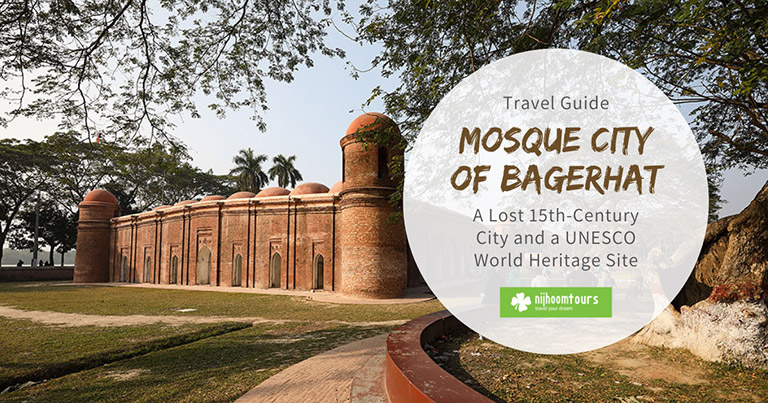
In the early fifteenth century on the inhospitable mangrove swamps of the Sundarbans, a beautiful township named Khalifatabad was founded by a saint-general named Ulugh Khan Jahan, which is current day Bagerhat, located on the south-western part of Bangladesh, and a UNESCO World Heritage site.
Khan Jahan was either forced by unknown political circumstances to immigrate, or he was specially commissioned by the court of Delhi to settle a Muslim colony in this distant region. This remarkable adventurer, who was undoubtedly the earliest torch bearer of Islam in the south, braved all natural hazards in this unclaimed swampland and systematically laid out the nucleus of an affluent capital city, unnoticed in the annals of the period.
Ulugh Khan Jahan, who was a contemporary of the independent Bengal Sultan Nasiruddin Muhammad Shah (1442-59), seems neither to have owed his allegiance to the Sultan nor to the Lodi Sultan of Delhi. He ruled over an extensive jungle territory in and around Khalifatabad, virtually as an independent chief, but seems never to have issued coins in this name or assumed any lofty sovereign title – the two prerogatives of an independent ruler.
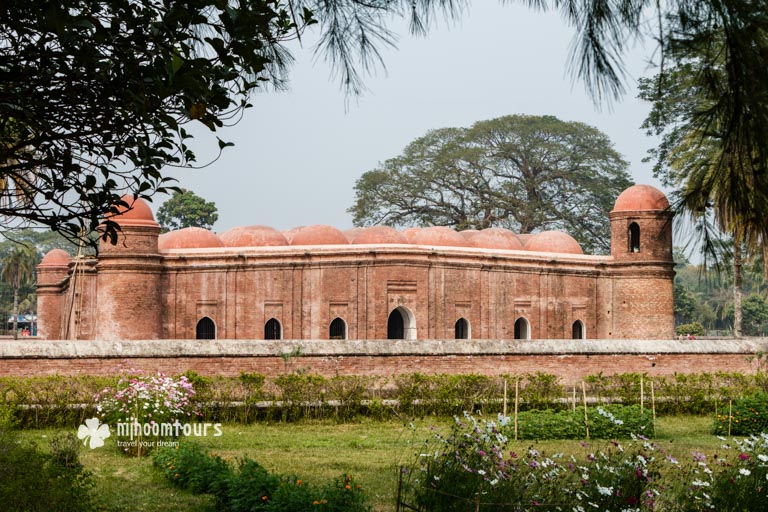
The Sixty Dome Mosque in Bagerhat. ©Photo Credit: Raw Hasan
Significant Structures of Bagerhat
Khan Jahan adorned his capital city with numerous mosques, – traditionally 360 in number – bridges, roads, reservoirs, palaces, mausoleum, and other public buildings in an astonishingly short span of time. It is said that Khan Jahan Ali marched through jungles with sixty thousand followers.
Every time he reached a major township, he left behind some of his disciples to engage in social work and continued to proceed southward with the rest of his entourage, and finally settled in Bagerhat. The saint’s primary objective in rendering the swampy southern region of Bengal habitable was to spread Islam. Some of the significant structures still remaining in the city are as follows.
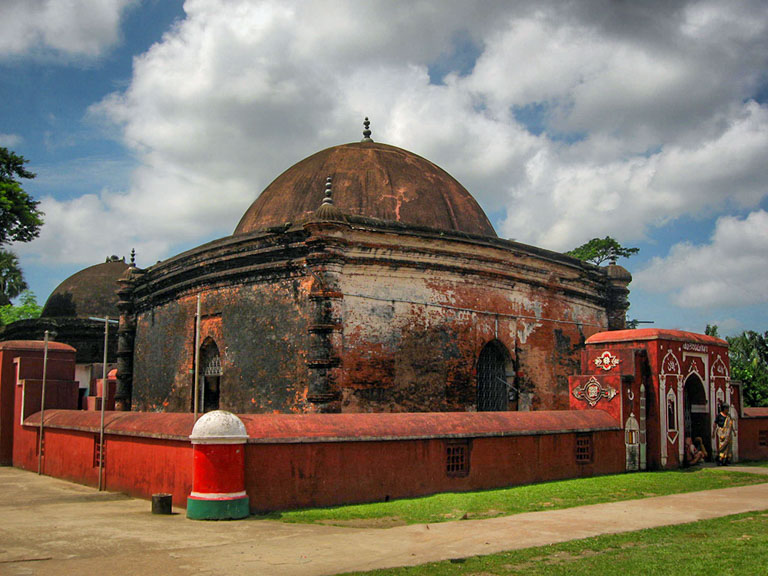
The shrine of Khan Jahan Ali, the founder of Bagerhat.
The Shrine of Khan Jahan
The chief monument in Bagerhat is the single-domed dargah serves as Khan Jahan’s mausoleum, which is located on the northern embankment of the Thakur Dighi. It is a common belief in Bagerhat that Khan Jahan Ali chose this site a few years before he died, and that he even laid a tombstone upon which his followers later recorded his death: Dhu al-Hijjah 27, 863 A.H. (October 25, 1459 C.E.).
The entrance of the shrine features a typical Bengali chau-chala vaulted roof situated between two broad, pointed-arch passageways. The central row of chou-chala domes is reminiscent of the bamboo rafters used in the rural huts of Bengal.
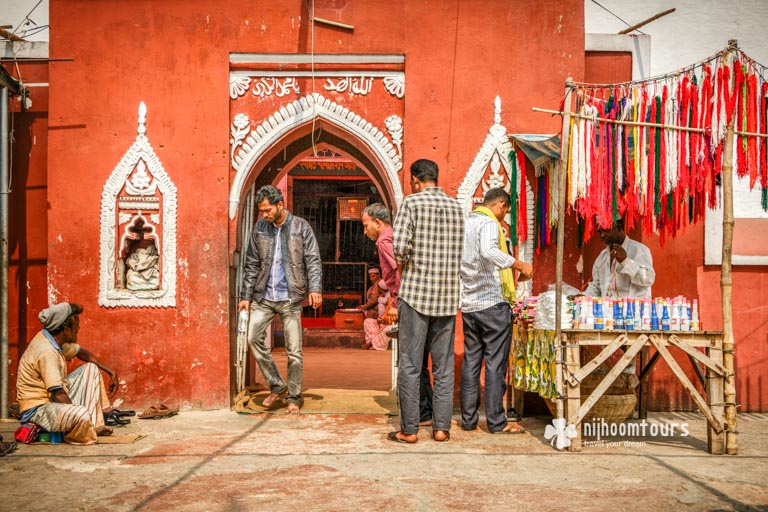
The entrance of the shrine of Khan Jahan Ali. ©Photo Credit: Raw Hasan
The tomb rests on a base of five rows of dressed black stone that derive their form directly from earlier Pala traditions.
Within the enclosed area to the west, there is an identical mosque with a stone tomb located between the two buildings. The tomb is traditionally ascribed to Pir Ali, alias Muhammad Tahir, a close associate of the saint.
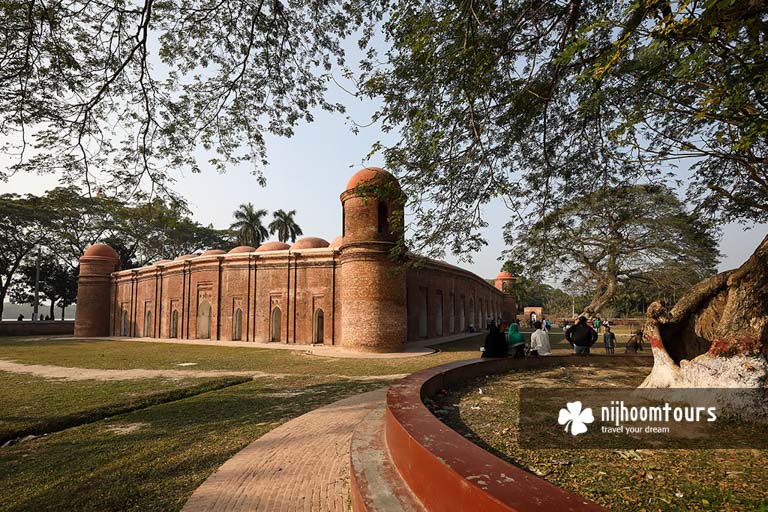
The Sixty Dome Mosque (Shat Gombuj Mosque) in Bagerhat City. © Photo Credit: Daniel Whitfield.
Sixty Dome Mosque
Among the many surviving monuments of the Khan Jahan style and undoubtedly the most magnificent and largest brick mosque in Bangladesh, is the so-called Sixty Dome Mosque. In reality, the mosque is roofed over with 77 small domes including seven chau-chala Bengali domes in the central row.
The prayer hall is 160’X190′ in size, which can accommodate about 2,000 people for prayer. It has 11 arched doorways on the east, and seven each on the north and south, for ventilation and light.
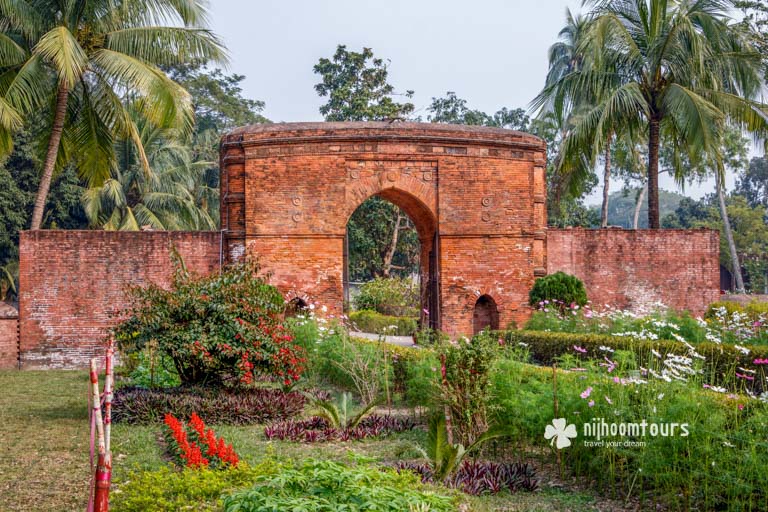
The entrance of the Sixty Dome Mosque in Bagerhat. ©Photo Credit: Raw Hasan
The sanctuary is divided by a forest of slender stone columns, into seven longitudinal aisles and eleven deep bays from which rows of endless arches spring to support the domes. The slightly battered 6′ thick walls and the almost detached circular corner turrets, each capped by small rounded cupolas, resemble the bastions of a fortress.
The central mihrab on the western sanctuary wall is of stone, whilst the flanking mihrabs are elegantly ornamented with terracotta floral scrolls in deep apses, with flanking pilasters and engrailed arches. The spandrels, however, are sparsely decorated with large expanding terracotta rosettes in the traditional art style of Bengal.
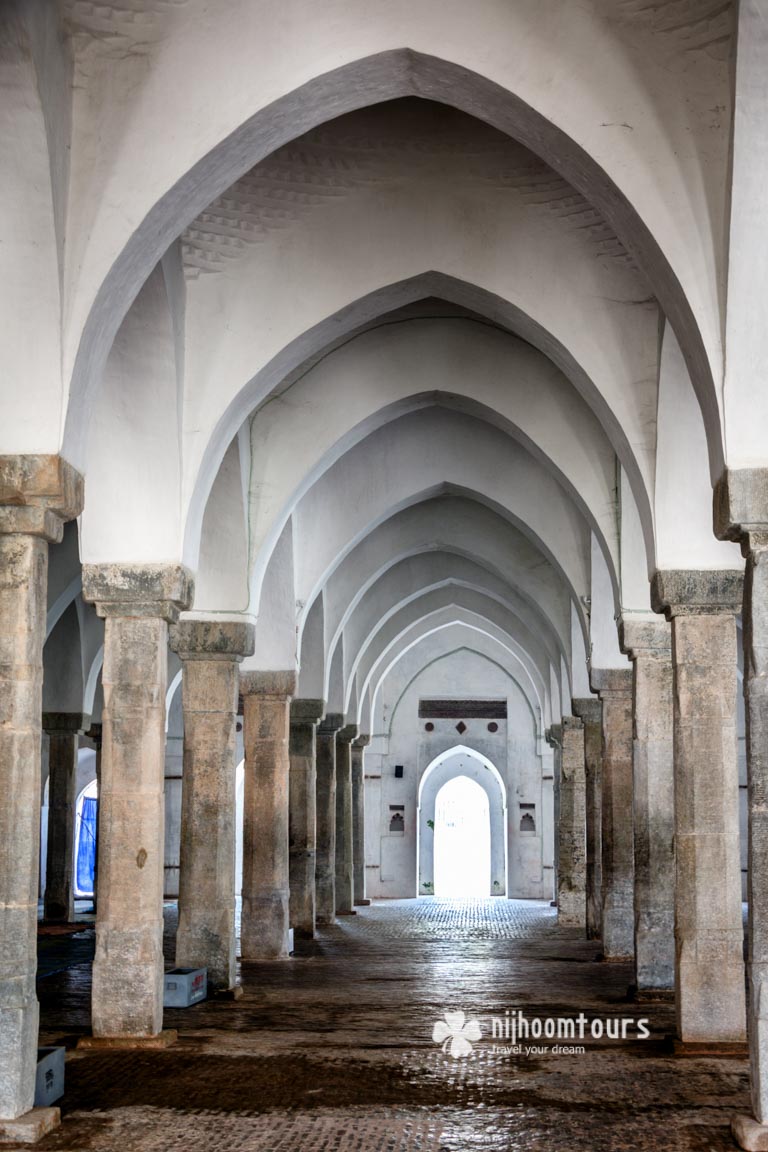
The interior of the Sixty Dome Mosque in Bagerhat. ©Photo Credit: Raw Hasan
Unlike most of the contemporary mosques of that time, there is no provision for an exclusive enclosure known as bahshah-ka-takht or “the King’s throne” in this mosque. However, there is a small arched doorway in the western wall close to the central mihrab which is an unusual feature. The western or the qibla wall, therefore, has only ten mihrabs instead of eleven.
The long bare and unplastered brick facade is relieved only by the typical curved Bengali battlements and cornice which, on the east, is broken in the center by a small triangular pediment from which the cornice slopes gracefully away towards the corner towers.
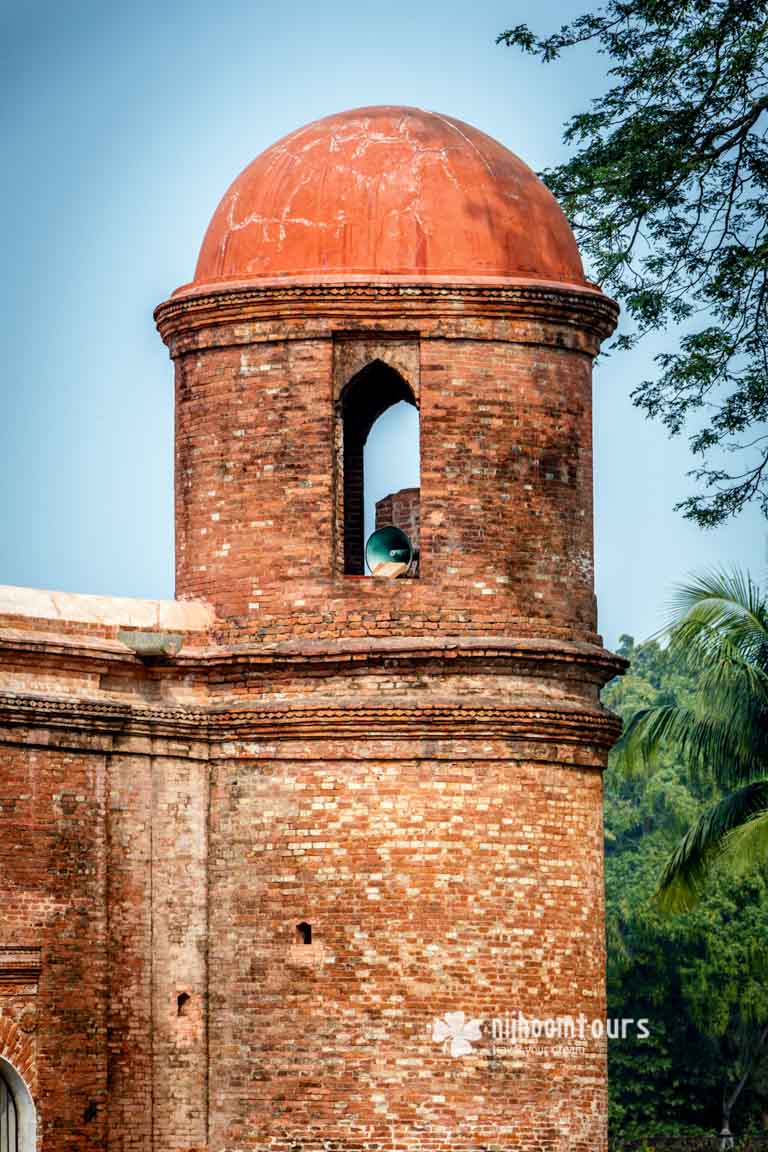
A corner tower of the Sixty Dome Mosque in Bagerhat. ©Photo Credit: Raw Hasan
In general appearance, this noble monument, with its stark simplicity and massiveness, strongly resembles the strength and austerity of the cyclopean grandeur of the Tughlaq architecture of Delhi.
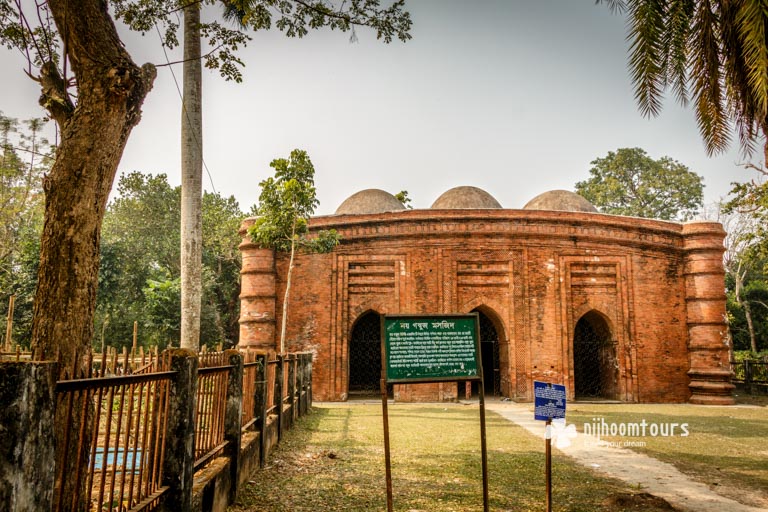
The Nine-Domed Mosque in Bagerhat. ©Photo Credit: Raw Hasan
Nine-Domed Mosque
The Nine-Domed Mosque, located on the western bank of Thakur Dighi, is an elegant squire mosque which has recently been extensively repaired. It is covered with nine low hemispherical domes supported on four slender stone columns. It has three arched entrances to the east, north, and south sides, and the western wall is relieved inside with three corresponding arched mihrabs, of which the central one is larger than the others.
The mihrabs are embellished with terracotta floral scrolls and foliage motifs within rectangular bands of panels, and the monotony of the plain 7′-8″ thick walls is only broken by the pairs of arched lamp niches on the west, north, and south walls. Prominent chain-and-bell terracotta motifs adorn the center of each mihrab.
The round corner turrets are divided by eight bands of moldings and the outer walls are relieved with tall vertical sunken panels terminating in pointed arches below the cornice. The ubiquitous curved cornice, which is a common feature of all these monuments, is also a feature of the decoration here.
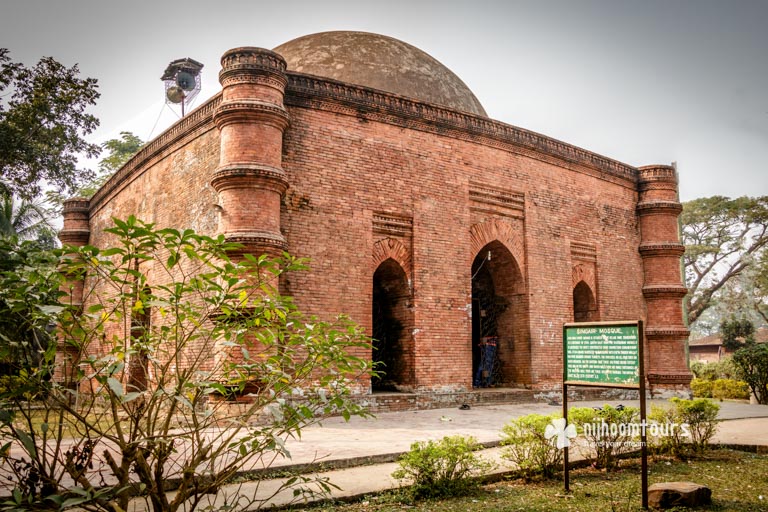
The Singair Mosque in Bagerhat. ©Photo Credit: Raw Hasan
Singair Mosque
The Singair Mosque is a 40′-9″ square single doomed structure with 7′ thick walls. It has four rounded corner turrets, relieved with five bands of brick moldings, and the cornices on all four sides are gently curved.
On the eastern face, there are three arched entrances within the rectangular frames, whilst on the north and south walls, there are single entrances. The central mihrab on the west wall, framed within rectangular brick moldings, is sparsely embellished with terracotta rosettes and foliate motifs.
The corner squinch and brick pendentives are plain, and brackets supporting them were probably of stone.
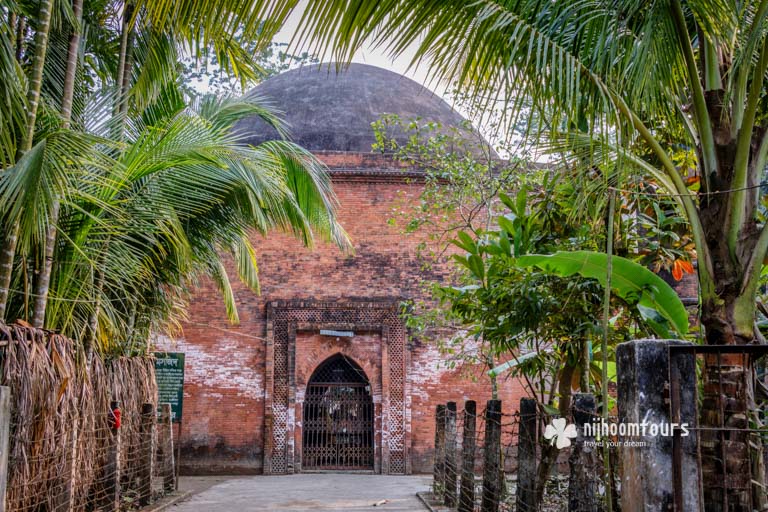
The Bibi Begni Mosque in Bagerhat. ©Photo Credit: Raw Hasan
Bibi Begni Mosque
The Bibi Begni Mosque is similar to the Singair Mosque in general, only larger and more massively built, with 9′-9″ thick walls. There are three arched entrances on the east and single arched openings on the north and south. corresponding to the three entrances, the west wall is relieved with three ornate mihrabs of which the central one is much larger than those flanking it. The mihrabs are bordered with rectangular moldings and ornamented with multi-cusped arches and terracotta floral panels, each of which has a prominent central chain-and-bell motif.
There are two arched lamp niches on each of the west, north, and south walls. The four-round corner turrets are divided by ten brick moldings but their crowning kiosks are missing.
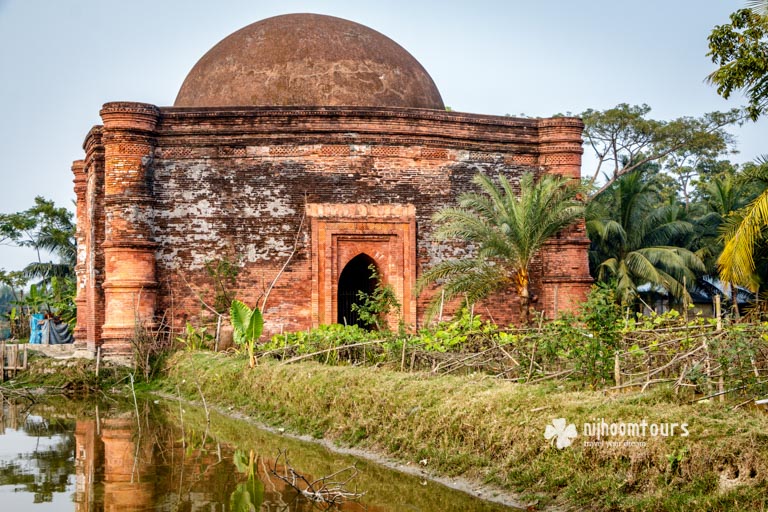
The Chunakhola Mosque in Bagerhat. ©Photo Credit: Raw Hasan
Chunakhola Mosque
Chunakhola Mosque is picturesquely located on an isolated low mound amidst an expanse of flat cultivated fields. In plan and elevation, this single domed small monument closely resembles the Singair Mosque and has similarly suffered heavily at the hands of the inclement weather of this area.
Reference:
- Discover the Monuments of Bangladesh, by Dr. Nazimuddin Ahmed
- The Mystic Contribution: Khan Jahan Ali and the Creation of Bagerhat, by Rudabeh Shahid
Have you ever visited the Mosque City of Bagerhat? How amazing have you found it? Which one is your favorite mosque at the Mosque City of Bagerhat and why? Have I missed something here? Share your thoughts and experience with us in the comments.
Take our Bagerhat Day Tour to visit the Mosque City of Bagerhat in a day from Dhaka.
Check out our 1-28 days Bangladesh tour packages and 3-8 days Sundarban Tour Packages in Bangladesh to visit Bangladesh with comfort.
